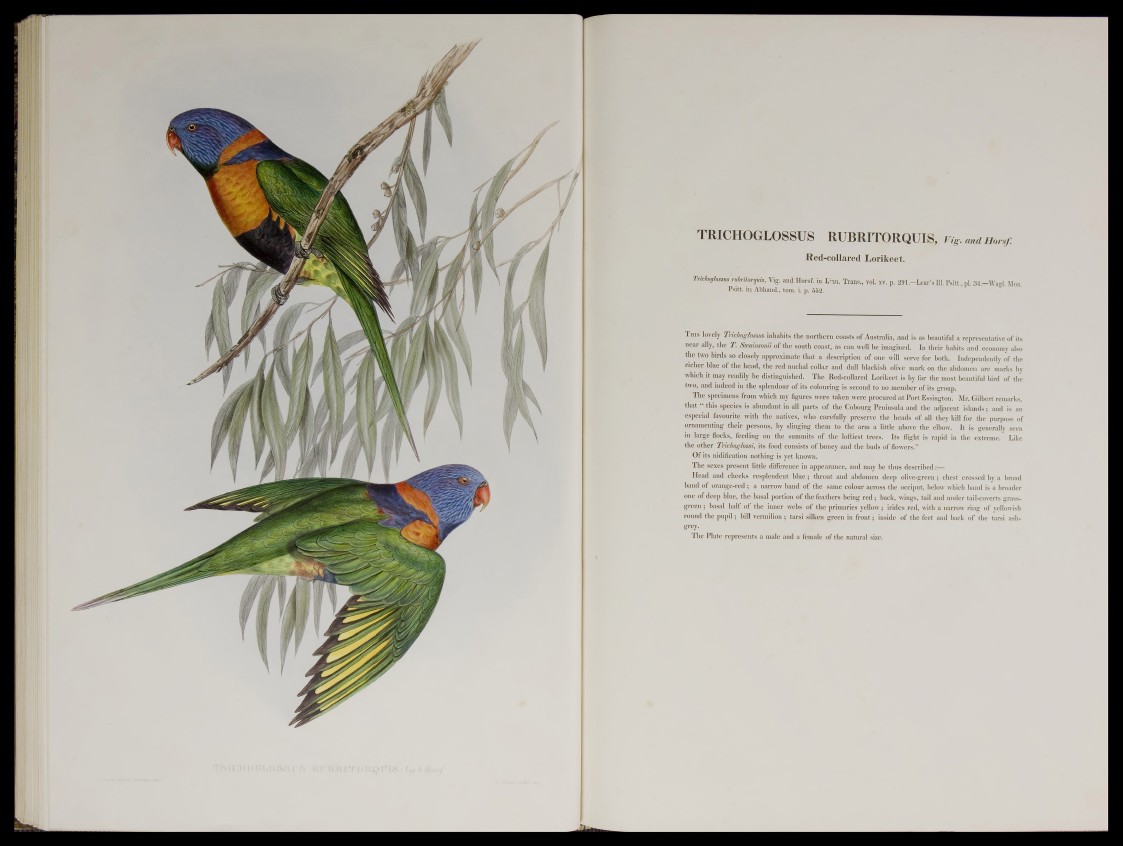
TRICHOCJLOSSUS RUCRITORQUIS, ng. andHortf.
Red-collared Lorikeet.
T rich o g h sn u r u ln to rq u u , Vjg, jsf e p ^ w ag': £ 2gl,-Lea£s I1J Fsitt, pi 34 —Wagl. Won.
foTeIy Tnckoglasm inhabits! the northern coa|ts of Australia, and is as beautiful a representative of its
near ally, the T. iI^mm-i, j s ,i mj.wU'lii ijjfilicii li Infs and economy also
M ^ tw o bijds so e lf^e Jy,approxrma tSh^^d«<ription'of SB SM ~ serve fcpfl&th. Independently of the
t*le re(l nuchal cellar andfju]| blackish q p e mark on the'abdomen are marks liy
whidi i t may readily b,e distinguished. |ji|p JM ic p )la re& lorikeet in by far the m o st'feu tifd bird of the
two, and indeed in the splendour digitsCQluurmgjr^eiorKj^to noiHrejn^eroflits groups
The specimens from vihieh,gw£gure.| were’taken we^proenjed <it Mr. Gilbert remarks,
W m P this species ig abundant in aj{; p M ® ^ Peninsula a p i'^ e , a c c e n t islands; and is an
especial favourite, y p l ; the natives, who carefully' p r ip m : the heads of all j'k d l for the purpose of
ornamenting t^eig.personsffhy s l i n g ^ them to *the'arm a’l i t t l ^ ^ g ^ f j i e elbijyvf I t is generally seen
ip large flocks, feedingfan thj^suirgnfe of the, lpftiept tyees. Its flight is rapid in the extreme lake
ri§S|||||jP Trichoglossi, its food' c o n s is t of honey and ilu'j biirb. .of flowers.!’
Of its nidification nothing is yet known,
,The sexes present little diflferenc,e in appearance, an(| p ay he t l y j ih - S r ih e d ^ ^ B
Head and cheeks resplendent blue; throat and abdomen dei p. olSe^reen*; chest crossed by a broad
lp s d S ‘OrWpe-r#i a jmxrdSyhflw|§l8 fee ,same|gpi^>u:ro..'> lLs^WipuMteiluB’ which band is a broader
one of deep blue, the basal portion of the feathers bejgg red; bachi' w in g d 't8 p |W under tail-coverts grassr
gre en; basal half of the inner webs of the primaries yellow; irides rjul,'.$dfbu^arrow ring of yellowish
round the pupih; bill v.ermilion; tarsi silken green pi fro n t; inside of the feet and back of the tarsi ash-
. . I
’The Plate represents a male and a female of the natural size;